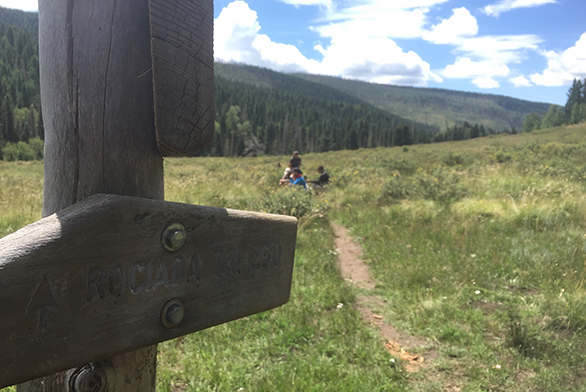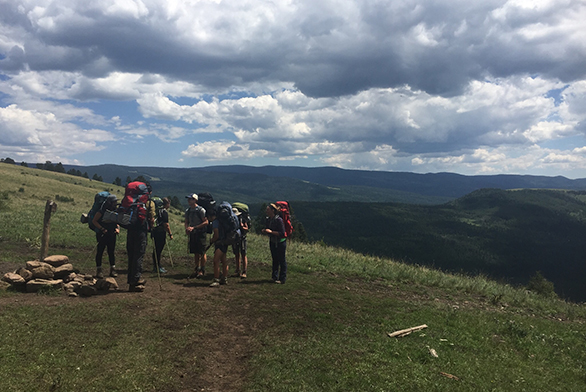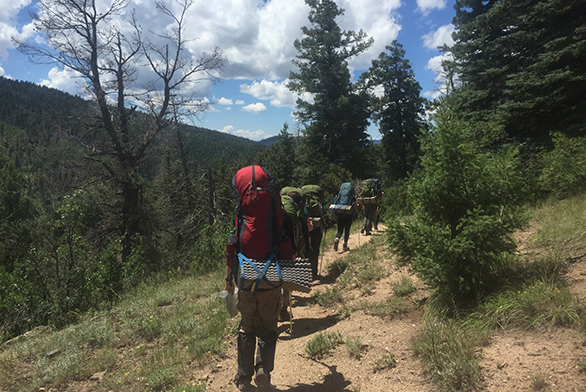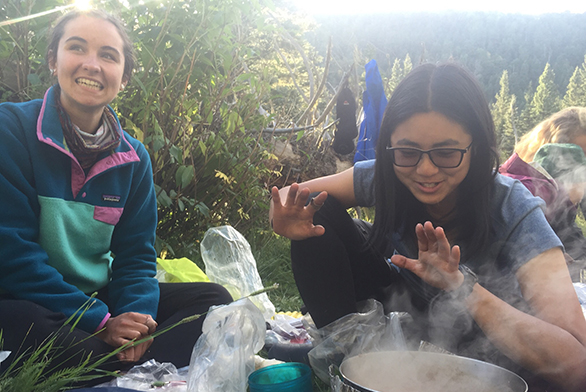Johnnies Growing in the Wild
December 14, 2016 | By Tim Pratt

Way out in the Pecos Wilderness of northern New Mexico, it was raining steadily as freshman Isabella Copeland and other St. John’s College students hiked through the backcountry.
They wore packs with all the items they would need for the nearly week-long trek: food, clothing, tents, sleeping bags, cooking equipment.
Some of the teens were accustomed to days-long journeys—hiking, setting up camp, cooking and sleeping under the stars. For others, this was their first such excursion.
But by the end, the 18 freshmen from the college’s Santa Fe campus had grown together. The rains had stopped. Bonds had formed. And the group was ready to begin their studies at St. John’s.
The teens had completed the Freshman Wilderness Orientation Trip.
The trip, organized through the Santa Fe campus’ popular Outdoor Program, is offered free of charge to incoming freshmen as an introduction to St. John’s life. And it continues to grow, giving students valuable outdoors skills, but also introducing them to fellow Johnnies who teach them what to expect over the next four years.
“The biggest benefit of it, I would argue, has nothing to do with the backpacking and survival skills they learn,” says Mike Thurber, coordinator of the Outdoor Program. “It’s an avenue for delivering the experience we really want, that of being in a really tight community.”
The Beginning
The idea for a wilderness leadership and freshman orientation program originated several years ago. The campus at one time had its own search-and-rescue team. When it was eliminated—students can still join the Atalaya Search and Rescue team in Santa Fe—it left a “void” on campus, Thurber says.

The Outdoor Program coordinator also wanted to give incoming freshmen an opportunity to meet each other, and learn from older students. The wilderness leadership and freshman orientation program would meet both of those needs.
“Rather than being dropped off at the dorms and being left to their own devices, they’re meeting this group of students who can help coach them through that process and provide some real insight into what they’re about to experience,” Thurber says.
The groundwork for the program began in the spring of 2014, with backpacking excursions for students in the New Mexico mountains. Thurber and others learned lessons from the outings, did some restructuring, and in the spring of 2015 took four students out into the wilderness for the inaugural 12-day leadership expedition.
The students learned “hard” skills, like how to navigate, use a map, tie knots, set up camp and use a stove, but they also learned “soft” skills, like conflict resolution techniques and how to use different leadership styles to be effective. They were being groomed to lead incoming students through the wilderness for the newly formed freshman orientation program.
In the fall of 2015, 10 freshmen went out into the wilderness—led by some of the students who months earlier had completed the leadership training—for the first edition of the orientation program.
Thurber and other trained guides, all of whom have extensive medical training, accompanied the students. The trip was a success, and it laid the groundwork for the program to grow.
In the spring of 2016, nearly a dozen students were selected for the 12-day leadership expedition; and more freshmen were selected for the six-day fall 2016 orientation program—18 in all, with a waiting list of 12, Thurber says.
Copeland, of California, was one of the freshmen selected to participate. She had some experience backpacking and an appreciation for the outdoors, but she also wanted to meet some of her future classmates.

“The backpacking part is fun, but the main reason I did it is I wanted to get to know people,” she says. “The kind of person who is willing to go out in the woods for a week is the kind of person I want to know.”
The Journey
Participants arrived on campus more than week before the rest of the freshman class in August. They underwent training—how to tie knots and set up camp, for example—and got to know each other. They were then transported to the Pecos Wilderness to begin their journey. The college provided the food and most of the gear the students would need.
The freshmen were split up into groups, with some of the students heading out clockwise on a miles-long loop through the wilderness and the others heading counter-clockwise. They would pass each other halfway through the journey.
The students hiked for several hours a day, though rest periods were built into their schedules. They were joined by older students who had completed the spring leadership expedition, along with their experienced guides and Thurber.
Thurber is a wilderness EMT, and the instructors are wilderness first responders. The older students also completed emergency training in the days before freshmen arrived. Thurber describes the orientation as a “safe and supportive” setting.
Trekking along the mountainous trails could be strenuous, Copeland says, but the experience helped build camaraderie among group members as they helped each other through difficult stretches. They cooked together and shared tents; they took in the scenery and learned about nature—what mushrooms they could eat, for example; and as they talked more and more, they got to know each other and developed bonds.
The older students on the trip not only helped guide the freshmen through the journey, they shared their knowledge of St. John’s.
“It was a very open, encouraging environment to discuss what to expect,” says Matthias Marklin, a senior from New Hampshire who helped lead a group of freshmen.

Marklin is an experienced backpacker who once spent three months trekking through the mountains of South America. He attended the St. John’s Annapolis campus his freshman year, but transferred to Santa Fe as a sophomore for what was supposed to be a one-year stint. He fell in love with the setting, however, and decided to stay instead of returning to Annapolis.
On the last day of the trek, Marklin’s group sat around a campfire and discussed a variety of topics, from student life to academics. Similar conversations took place throughout the journey in Marklin's group and others.
“We tried to give it a good balance of both; being out in the wilderness and learning new skills, but also keeping in mind they’re starting a new chapter of their life,” he says.

